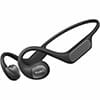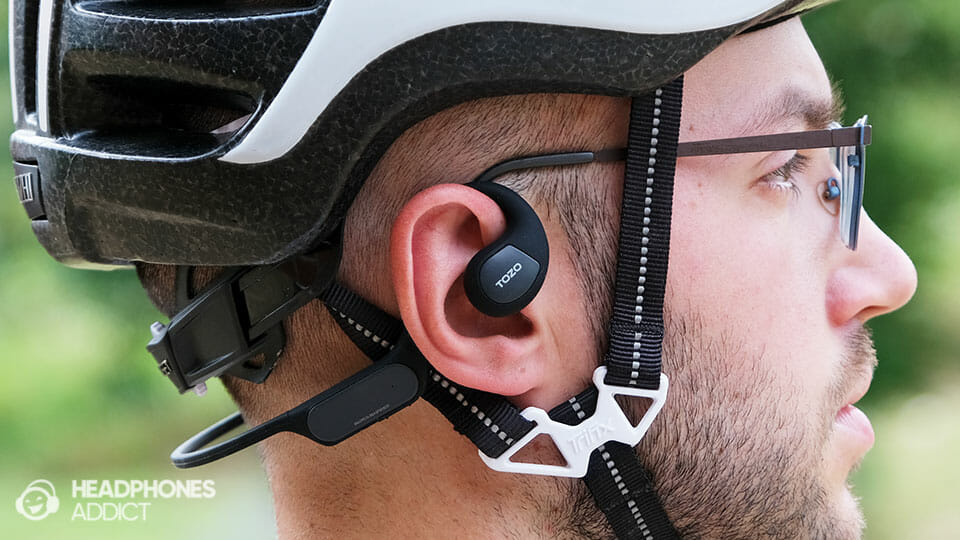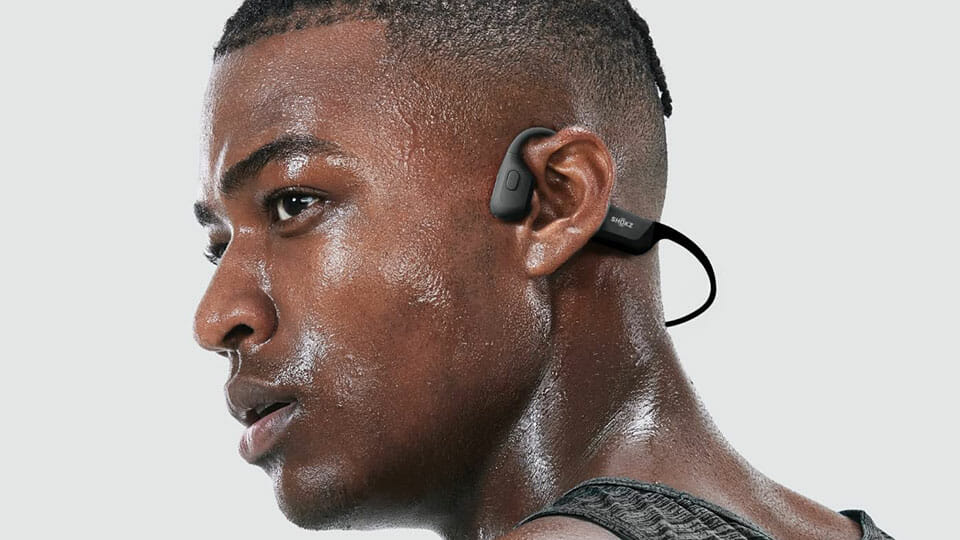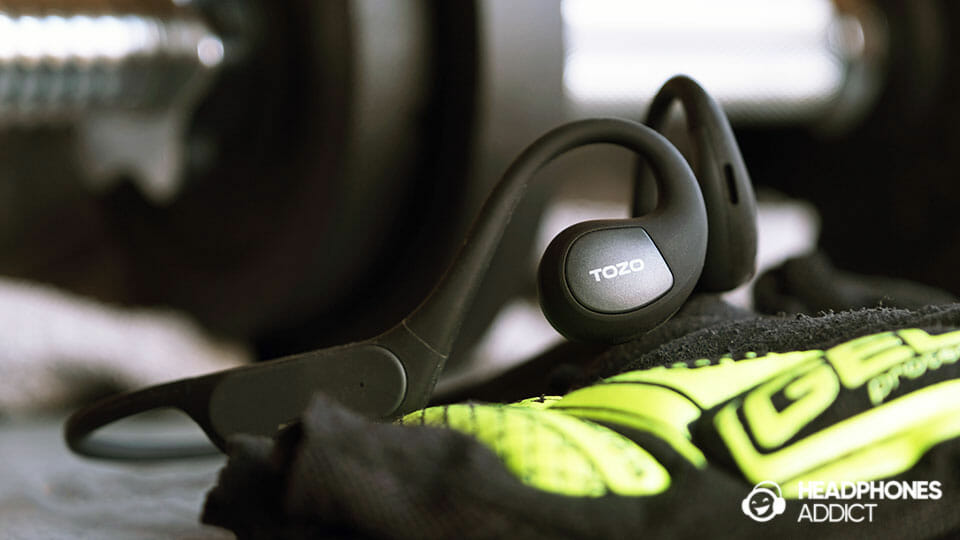We tested 192 headphones. Plus, 8 open-ear headphones for this guide.
We can confidently say these 5 are the best on the market. In this guide, we’ll cover:
- The best open-ear headphones and earbuds that let you fully hear your surroundings.
- What to look for in the best open-ear headphones?
- Why pick bone conduction over open-air headphones?
| Amazon rating | Price | Battery | Water protection | Sound quality rating (1-5) | Comfort & fit rating (1-5) | More info | |
|---|---|---|---|---|---|---|---|
|
TOZO OpenReal
Best overall
 |
4.3
|
Under $50
|
12 hours (proprietary charger)
|
IPX8
|
4.5
|
4.5
|
|
|
Mojawa Run Plus
Best bone conduction

|
4.1
|
Under $130
|
8 hours (proprietary charger)
|
IP68
|
4.0
|
4.0
|
|
|
SoundPEATS RunFree
Runner-up

|
4.3
|
Under $50
|
12.5 hours (USB-C)
|
IPX4
|
4.0
|
4.5
|
|
|
SoundPEATS RunFree Lite
Best cheap

|
3.8
|
Under $30
|
20 hours (USB-C)
|
IPX4
|
3.5
|
5.0
|
|
|
TOZO OpenBuds
Best true wireless

|
4.7
|
Under $70
|
7.5h + 30h in case (USB-C)
|
IPX6
|
3.0
|
5.0
|
How did we measure the main criteria to decide the best open-ear headphones?
Open-ear headphones are made for active users who want to listen to music while working out and maintain awareness of their surroundings.
Consequently, the best open-ear headphones must perform well in these 4 categories:
Let’s quickly explain what we look for in these 4 categories.
Comfort
When taking headphones on a workout, you will use them for multiple hours straight. Therefore, headphones must be comfortable and lightweight enough not to bother you or cause pain or headaches.

Sound quality
You’re using headphones mainly to listen to music, so they should produce satisfying audio quality.
Unlike in other headphones, we don’t look for audiophile-grade quality. Instead, we expect the sound to be punchy to give you energy and rhythm during a workout. Any other audio improvements (better clarity, details) are a pleasant bonus.
Durability
Headphones must have at least an IPX4 rating, preferably IPX5. The first ensures full sweat resistance, while the second means you can also use them in rainy conditions.

Furthermore, headphones must be flexible. You don’t want to bend them when stretching them over your head.
Ease of use
During sports activities, your hands are busy doing other things, such as lifting weights, holding bicycle bars, maintaining balance when running, etc. So, you don’t have time to control playback via smartphone.
That’s why onboard controls must be intuitive, easily located with your fingers, and provide feedback (an auditory beep or a distinct click after pressing the button).

We haven’t mentioned “stability” or “battery life”. We expect stability from all open-ear headphones by default, while the battery life is typically higher than 8 hours, which is already more than enough for 2-3 workout sessions.
We made practical tests like taking headphones on a bike ride or outdoor run to test the criteria above. That’s how we get a bigger picture of how headphones perform “in the wild”.
Furthermore, we have experience testing other types of headphones. So, we have high standards of what we consider worthy of a recommendation.
Best Open-Ear Headphones in 2023
1. TOZO OpenReal

TOZO OpenReal tick all the boxes for the best open-ear headphones, providing good sound, comfort, durability, and a long battery life with only one weak feature. Find out below or in the TOZO OpenReal review.
- Incredibly natural tuning, especially after EQ
- Ergonomic design for rock-solid stability
- Comfortable to wear & compatible with bike helmets
- Good battery duration of 12 hours per charge
- Exceptional Bluetooth indoor range of 65 feet
- Annoying proprietary charger with weak magnets
- No support for Bluetooth multipoint or Game mode
TOZO OpenReal are one of the biggest surprises in this category of headphones as they deliver incredibly natural sound.
While still lacking bass extension, the music sounds full and lush, with good extension in the treble. That makes them suitable for any music genre except the ones that rely fully on bass (hip-hop).
To achieve such a good sound, you must use the TOZO app. Speaking of the app, it primarily offers sound customizations and more accurate battery percentages.
You get 12 hours of battery life on a single charge at 50% volume. Since headphones are loud, you’ll probably use them at a lower volume, which increases the battery duration.
OpenReal are one of the few open-air headphones with an IPX8 rating. This means you can wash them in water without the fear of inflicting damage. Sadly, they lack a multi-point connection and a Game mode, making them less ideal for multitasking and gaming.
2. Mojawa Run Plus

Run Plus leaped forward in sound quality using bone conduction technology and are even capable of underwater use. There are just a few problems – Mojawa Run Plus review.
- Most balanced sound from bone-conductive headphones
- Stable fit, suitable for intense sports activities
- Onboard MP3 player for outdoor runners & swimmers
- Quality build with an IP68 rating
- Bluetooth multipoint support
- Mediocre call quality muffles your voice
- Pretty noticeable bass distortion
While most bone-conduction headphones produce harsh, messy sound, the Run Plus actually deliver sound that’s incredibly balanced. They’re still shouty but much less than any other headphones of this type.
Furthermore, headphones feature 32 gigabytes of onboard storage. That’s enough for 8000 MP3 songs, but they also support AAC, FLAC, WAV, M4A, and APE files.
Moreover, thanks to an IP68 rating, you can use these headphones in the pool, down to 2 meters in depth.
A battery life of 8.5 hours is satisfying enough for a lengthy workout or two. Fortunately, due to really fast charging, they can go from 0-100% in just 50 minutes.
The only two issues we could find were occasional bass distortion and louder-than-usual sound leakage.
3. SoundPEATS Run Free

SoundPEATS RunFree are a refined version of the Lite version, producing clearer sound and using more premium build materials. But they’re a fingerprint and dust magnet – SoundPEATS RunFree review.
- Great sound quality for this type of headphones
- Stable & comfortable fit thanks to "liquid" silicone finish
- Solid Bluetooth connection with 60 feet of indoor range
- Good microphone quality in quieter places
- But poor mic quality in louder places
- Rubber flap protecting the USB-C port looks fragile
- IPX4 rating is relatively low for sports headphones
After applying our EQ settings, the RunFree produce a pretty neutral-sounding midrange and treble. While lacking some control in the lows and detail in the highs, these things are hardly noticeable during sports activities.
To withstand workouts, headphones have an IPX4 rating, ensuring complete sweat resistance. Remember to carefully open the rubber flap protecting the USB-C charging port so you don’t tear it.
Headphones play music for up to 12.5 hours on a single charge at 50% volume. However, since they’re relatively quiet, you need to push them to at least 60%. So, expect shorter battery durations.
As for the features, RunFree offers Bluetooth multipoint for connecting to two devices simultaneously and a Game mode. The latter reduces the audio latency to 88 milliseconds.
4. SoundPEATS RunFree Lite

RunFree Lite are a slightly trimmed-down version of the non-Lite model, offering a simpler design and softer sound but a much better battery for less than $30 – SoundPEATS RunFree Lite review.
- Full, natural sound (after EQ)
- Long battery life of 20 hours per charge
- Outstanding stability & long-lasting comfort
- Feature-rich companion app
- Robust Bluetooth connection with multipoint support
- Cheaper-feeling construction
- Quiet, somewhat muffled sound output & slight distortion
RunFree Lite are noticeably bassier than the non-Lite version but also softer overall. That results in hearing less details. However, using our EQ settings, the sound remains enjoyable even during a mountain bike descent.
Due to cost savings, headphones use mostly cheaper plastic. Only the neckband part is covered in softer rubber. On the flip side, they’re one of the comfiest open-ear headphones we’ve tested.
Moreover, they last the longest, with a battery life of 20 hours per charge. And because of the more intuitive position of the rubber flap, they’re also less annoying to charge than the RunFree model.
Lastly, the headphones have an IPX4 rating and a full-fledged companion app with custom EQ, Adaptive EQ, Game mode, and multipoint support. For under $30!
5. TOZO OpenBuds

TOZO OpenBuds convince with a unique open-ear design and impeccable comfort but could use more in-depth features to tweak some of the issues – TOZO OpenBuds review.
- Comfortable & stable fit with multi-angle ear hooks
- IPX6 rating is high enough for all sports except swimming
- Full surrounding awareness thanks to air-conduction design
- Long battery life at 7.5h, albiet not as advertised
- Great indoor Bluetooth range of 50 feet & multipoint
- Disappointing treble ruins sound quality
- No customizable audio equalizer
OpenBuds have the fullest bass extension out of all open-ear headphones and a surprisingly tactile punch. However, these earbuds aren’t for treble-sensitive users due to the occasionally sibilant highs.
Pairing them to a TOZO app lets you customize touch controls and change EQ presets. Sadly, you can’t customize the EQ.
Earbuds’ most unique feature is “biaxial rotating” ear hooks that comfortably grab your ears. It’s also very easy to attach the earbuds using only one hand. As expected, they provide a solid grip suitable for all sports activities.
Rated for an IPX6, OpenBuds can withstand sweat, rain, and even splashes from a showerhead. That said, avoid leaving them underwater as they aren’t fully waterproof.
These best open wireless earbuds should last you for an entire week with up to 7.5 hours on a single charge and another 30 hours inside the charging case. Sadly, no Qi wireless charging available.
Honorable Mentions: Open-Ear Headphones You Can Also Consider
Shokz OpenRun Pro

Shokz is the bone-conduction industry giant, and the OpenRun Pro is their flagship model.
They’re comfortable and produce a bold bass response without distortion but lack a more well-rounded feature set of the Mojawa Run Plus.
Why Trust HeadphonesAddict
At HeadphonesAddict, we always compare the new headphones to a reference to observe what is better and what is worse. If possible, we perform objective measurements to avoid personal bias.
When choosing the best open-ear headphones, we looked at the comfort, sound quality, feature customizability, durability, and quality of materials. We also consider the value when picking the best budget option.

Like you, we also sometimes seek advice from others. Just like we expect others to offer us unbiased, professional opinions, we strive to do the same for you.
More reasons to trust us:
- We test headphones on 9 key points.
- We don’t take money for tests and reviews.
- We don’t delete or edit “bad reviews.” Even when brands ask us to. If the headphones sound bad or have other faults, we tell you about it without embellishment.
Read more about our headphone test process.
How to Buy the Perfect Open-Ear Headphones for You
As mentioned above, there are 4 things you should look for in open-ear headphones: comfort, sound, durability, and ease of use. Battery, stability, and Bluetooth connectivity are already great in all of these headphones, so you shouldn’t focus too much on that.
- In comfort, ensure the headphones sit gently on your head. If you feel pressure on the first try, it will slowly develop into pain.
- In terms of sound, try to get the clearest-sounding headphones if you want to enjoy music. Or pick the punchiest if you want the music to give you rhythm during workouts.
- In durability, ensure that the IP rating matches your sports activity. IPX4 is for the gym, IPX4 or up is for outdoor use, and IPX7 (preferably IPX8) is for underwater use.
- Lastly, for ease of use, look for physical controls as they’re more reliable. Ensure they’re easy to locate with your finger.
Should I get open-ear over bone-conduction headphones?
Always pick open-air headphones over the bone-conduction when looking for open headphones.
Here’s why:
Bone conduction headphones are pricier and offer worse sound performance. However, they’re the only option in case of medical issues or outer ear deformation, which prevents you from using conventional headphones.

The good news is that most great open-air headphones cost less than $100, even less than $50.
What are the differences between open-ear headphones at different prices?
Differences between different price points mainly consist of sound and build quality, less in features.
Open-ear headphones around $30:
- The sound is noticeably muffled and less detailed. They’re still okay for casual listening, but don’t make you sing alone.
- Feel more plasticky, with less premium materials like titanium or other solid but flexible metals.
Open-ear headphones around $50:
- The sound is clearer and slightly more controlled. The bass feels more tactile and audible. The benefit of that is to give rhythm when working out.
- Have better build materials, with a soft silicone finish covering many parts. The housing is usually thinner to boost the aesthetic appeal.

Open-ear headphones above $50:
- The sound is even clearer but not necessarily more detailed. They produce a punchier, more distinct bass kick.
- Use different design solutions to achieve a better user experience. Like turning headphones into earbuds by giving them ear hooks (TOZO OpenBuds).
Interestingly, features remain pretty similar between different price points. However, the most important feature is the customizable audio equalizer. Here’s why.
People’s ears are different, so they “hear” frequencies differently. Since you might get a different listening experience than an audio engineer tuning the headphones, you need a way to personalize the sound.
That’s when custom EQ comes in handy, ensuring you can squeeze the best sound quality possible out of every product.

What to Expect from Open-Ear Headphones
The most significant feature of open-ear headphones is that they offer perfect awareness of the surroundings. However, there are benefits and downsides to that. Let’s see all the pros and cons.
- Perfect awareness
Open-ear headphones (open-air or bone conduction) don’t block your ear canal. This means you can hear ambient sound (everything around you).
The main benefit is increased safety, as you’re more aware of nearby dangers like passing cars, sirens, other peoples’ screaming, etc.
- Rock-solid stability
Adopting an ear hook design, open-ear headphones always provide excellent stability. It would be shocking to encounter a model that keeps falling off our heads.

- Solid battery life
Most open-ear headphones have at least 8 hours of battery life or above, enough for around 2 or 3 listening sessions.
If there’s one potential issue, it is that some brands insist on proprietary charging solutions that aren’t convenient or are straight-out terrible (TOZO OpenReal).
- Robust Bluetooth connectivity
Most open-ear headphones we’ve tested have the latest Bluetooth versions (Bluetooth 5.3). Newer versions use more sophisticated protocols to ensure zero audio stutters, even with other Bluetooth devices around you (others use wireless headphones in the gym).
Furthermore, most headphones have an above-average indoor range of around 60 feet (18.3 meters). This indicates they’re using stronger Bluetooth antennas for receiving the signal.

- Zero isolation
Perfect awareness comes at the cost of passive noise isolation, which is practically non-existent. Having noise isolation means external sounds can interfere with your music, forcing you to raise the loudness.
- Good but never audiophile-like sound
Lower frequencies struggle to sound full without an ear canal seal. So, you can forget about the sub-bass rumble. The bass extension is even worse than in open-back headphones.
That said, midrange and treble sound really good on newer models. With the progress of technology, open-ear headphones might someday sound as good as other types of headphones.
How to Pick Open-Ear Headphones That Will Last
Open-ear headphones are designed primarily for sports. This means 2 things:
- They will get frequently soaked in sweat and possibly even rain if you exercise outside a lot.
- They will get frequently tossed around or stretched too much when putting them on your head or over a cycling helmet.
Consequently, if you want your new open-ear headphones to last, you need to look for these features:
High IP rating
You must look for at least an IPX4 rating, preferably a higher one. IPX4 means your headphones are tested against sweat and light water splashes, like running in a light rain.
Higher IPX ratings mean surviving even harsher conditions, like listening to music in the shower or washing the headphones under a tap. The latter is only advisable with an IPX7 rating or above.

If you want to make extra sure outdoor activities can’t hurt your new headphones, also look for an IP4X rating or above ratings.
That means headphones resist dust particles of various sizes that can damage the internal components. However, dust resistance ratings are relatively uncommon.
Durable build
Cheaper neckband open-ear headphones are made mostly from plastic. Hard plastic is more susceptible to cracking upon impact than metal or housing that’s covered in soft silicone.
Look for longer warranty coverage
Longer warranty coverage ensures the manufacturer must repair everything that isn’t inflicted by you. While batteries are typically covered only for a year, other repairs differ from brand to brand.
Here’s a table of popular open-ear headphone brands and how long they cover your headphones:
| Brand | Warranty duration | Returns (after purchase) |
|---|---|---|
| Shokz | 2 years (internationally) 1 year (China, Taiwan Hong Kong, Macao) | 45 days |
| Bose | 2 years (UK & EU) 1 year in the USA | 90 days |
| TOZO | 1.5 years (after registering your headphones) | 30 days |
| SoundPEATS | 1 year (internationally) | 30 days |
| Mojawa | 2 years | 30 days |
Try avoiding rubber flaps
Manufacturers sometimes use rubber flaps to cover charging ports. The issue with flaps is they easily tear off, leaving you with an exposed port, which renders an IP rating useless.

That said, quite a few open-ear headphones use rubber flaps, so they’re harder to avoid than we’d like. The only solution is proprietary ports (TOZO, Shokz), which can be highly impractical.
Open-Ear Headphones We Considered but Didn’t Make the Cut
Here are the open-ear headphones that didn’t make the cut:
- Mojawa Mojo 2: The sound lacks bass and gets occasionally sharp in the treble. The battery is also below average at 5.5 hours per charge.
- Orange O Bones: Audio is way too exciting to the point of being sibilant. Headphones are also light on features and offer mediocre call quality. However, their battery lasts for almost 11 hours per charge.
- TrueFree F1: Cheap and with a secure fit, but not as comfy as the rest. They have a decent sound, but it’s a bit bland compared to the competition.
Open-ear headphones can also be sunglasses with speakers. The Bose Frames series is the most famous, but other brands are making them, too.
Furthermore, some open-ear models come as a module with a clip to attach to your regular glasses.
We didn’t add these types of headphones in our guide because we have yet to have an opportunity to test some.
FAQ: Frequently Asked Questions
Are open-ear headphones good?
Are there open-ear earbuds?
Yes, there are open-ear earbuds such as TOZO OpenBuds or Skullcandy Push Ultra.
Do open-ear headphones leak sound?
All open-ear headphones leak sound to some degree, which is normal. However, some leak it more than others. Unless you plan to use them in the library, you should worry about that.
What is the difference between in-ear and open-ear headphones?
The difference between in-ear and open-ear headphones is that in-ears seal your ear canals, improving bass response and isolation. At the same time, open-ears provide full awareness to increase your safety.
Conclusion
We believe TOZO OpenReal are the best, as they pass every criterion with flying colors.
Lastly, check our guides on similar types of headphones like:

From a childhood fascination with sound, Peter’s passion has evolved into a relentless pursuit of the finest headphones. He’s an audio expert with over 5 years of experience in testing both audiophile and consumer-grade headphones. Quote: “After many years, I can confidently tell which headphones are good and which are terrible.” Find his honest opinion in his reviews.







